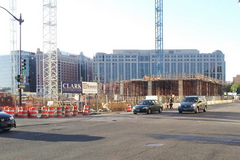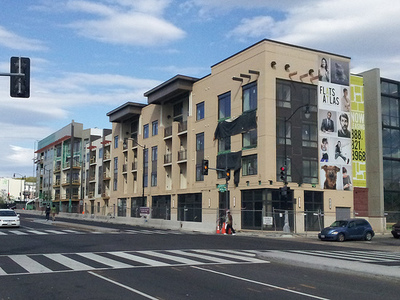Too many construction sites close sidewalks without walkway
A DDOT policy requires construction sites to maintain a walkway for pedestrians. But at numerous sites around the city, this doesn’t happen. Many construction sites inconvenience and endanger pedestrians, while site developers use former sidewalks as staging areas.
DDOT’s Pedestrian Safety and Work Zone Standards Order from 2007 states: “Traffic control plans should replicate the existing pedestrian pathway as nearly as practical and that the pedestrian pathway should not be severed or moved for non-construction activities such as parking for vehicles or the storage of materials or equipment.”
However, numerous construction sites are not following this policy, and DDOT could do more to enforce it.
In the heart of downtown, the CityCenter site has been under construction for over a year. Construction has taken over the sidewalk around more than ¾ of the site, yet only the northern section has any temporary walkway.
On any given day, pedestrians walk along the construction fencing on 9th, 11th, and H Streets, in traffic because they don’t want to deal with the hassle and delay of sometimes 4 additional crosswalks to get to their destinations.
Throughout the site excavation, the developer closed all the sidewalks. This happened despite DDOT’s policy stating that an open or covered walkway should be provided on the sidewalk if possible, or otherwise in the roadway. Once frame construction begins, which happened recently, the preference then is a covered walkway in the roadway.
At the construction site of the Convention Center hotel a few blocks north, at 9th and Massachusetts NW, the sidewalks there have also been closed for months throughout multiple stages of construction.
The problem is not unique to Northwest. In Northeast, on Bladensburg Road near the “starburst” intersection, the sidewalk is closed for an entire block on the north side, where a new condo development is rising. In Southeast, in the Navy Yard area, sidewalks are closed at 4th Street by the upcoming Boilermaker Shops, and on various blocks around the last phase of EYA’s Capitol Quarter townhome development.


Left: Next to the Boilermaker Shops on 4th St SE.
Right: Sidewalks closed for Capitol Quarter construction on L St SE.
In some cases, upon receiving complaints, DDOT has inspected sites like these and then ordered the developer to provide a walkway. This is good, but pedestrian accommodation should not be reactionary. It needs to be a priority in the traffic management and permitting process.
Where sidewalk space is tight, DDOT should show leadership and use road space to create temporary walkways. Pedestrians should not have to bear the sole inconvenience of the construction. Sometimes it means closing a lane of traffic to move the sidewalk (and bike lane where necessary) out from their original location.
Stronger policies and enforcement will encourage developers to use their available space to its maximum extent, instead of leaving tools and junk lying around like the picture to the right. If they are forced to get permits for walkways in the roadway, this will also encourage them to bring construction activities back within the parcel envelope as quickly as possible, to the benefit of everyone.
On the northeast corner of the CityCenter site, the developer has managed to preserve close to 100 public parking spaces. In light of this, saying that the sidewalks have to be closed because of space constraints is simply insulting.
Some may say that the inconvenience people on foot face by having to cross the street is minor, and doesn’t merit burdening construction planners with stricter requirements and additional safety measures, or potentially inconveniencing drivers by closing a lane of traffic. Yet we impose all kinds of other, more onerous restrictions on developers for far more capricious reasons.
Closing a sidewalk on one side of the street inconveniences pedestrians in the same way that closing a two-way street to one entire direction of traffic would drivers. If I am walking 4 blocks along one side of the street, and the sidewalk is closed for one of them, I have to cross at least two additional times, assuming there are no mid-block alleys, and the intersections are all simple 4-way intersections. This means waiting at least two additional light cycles and walking out of my way.
Many pedestrians choose not to endure the inconvenience, and instead endanger themselves and others by walking in the street rather than crossing.
Only in the rarest of cases are motorists asked to endure months-long closures like this. Why, then do DC’s pedestrians have to deal with this every day?
As DC’s urban population grows and development activity picks up again, it may be time to revisit the pedestrian accommodation policy. In the meantime, DDOT needs to better use the policy it has in place to keep pedestrians safe.
Where else in the city have builders been allowed to close sidewalks? Post them in the comments.





